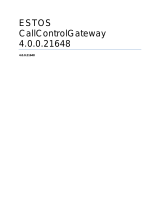
18 Converged Office component overview
•
the Mediation Server performs all necessary media transcoding and
routes the call to the IP-PSTN gateway.
•
the IP-PSTN gateway, based on topology, applies local or PBX dialing
rules and passes the call to the PSTN or PBX
Enterprise Voice uses Real-Time Transport Protocol (RTP) for media. Like
SIP, RTP is an Internet Engineering Task Force (IETF) standard. It defines a
packet format to carry audio and video over IP networks.
Enterprise Voice uses SIP for signaling and RTP for media. In the OCS,
SIP is used for IM, conferencing, presence subscriptions, video, and voice
enabling Enterprise Voice clients to provide a common user experience
across the communication modes.
Enterprise Voice is the Microsoft SIP–based implementation of IP telephony
for the Enterprise.
SIP sessions can include the sharing of real-time media. However, SIP
itself does not handle the actual media data, such as audio, video, and
application sharing. This separation means that SIP and various media
protocols can evolve independently.
OCS 2007 Voice components
The core routing components for Enterprise Voice reside on the following:
•
Standard Edition Server (in the role of Front End Server or Director)
•
Enterprise Edition Front End Server
Other core routing server components include
• Translation Service—translates a dialed number into E.164 format
based on the normalization rules defined by the administrator.
•
Inbound Router—handles incoming calls according to user-specified
preferences.
•
Outbound Router—routes calls to CS 1000 or PSTN destinations after it
applies authorization rules to callers and determines the optimal media
gateway to route each call.
OCS 2007 Front End or Director components essential for voice support,
but are not voice components include
•
User Services—performs Reverse Number Look-up on the target phone
number for incoming phone calls.
• User Replicator—extracts user phone numbers from the Active Directory
for use by User Services and the Address Book Service.
Nortel Communication Server 1000
Nortel Converged Office Fundamentals — Microsoft Office Communications Server 2007
NN43001-121 01.03 Standard
Release 5.0 30 April 2008
Copyright © 2005–2008, Nortel Networks
.





















